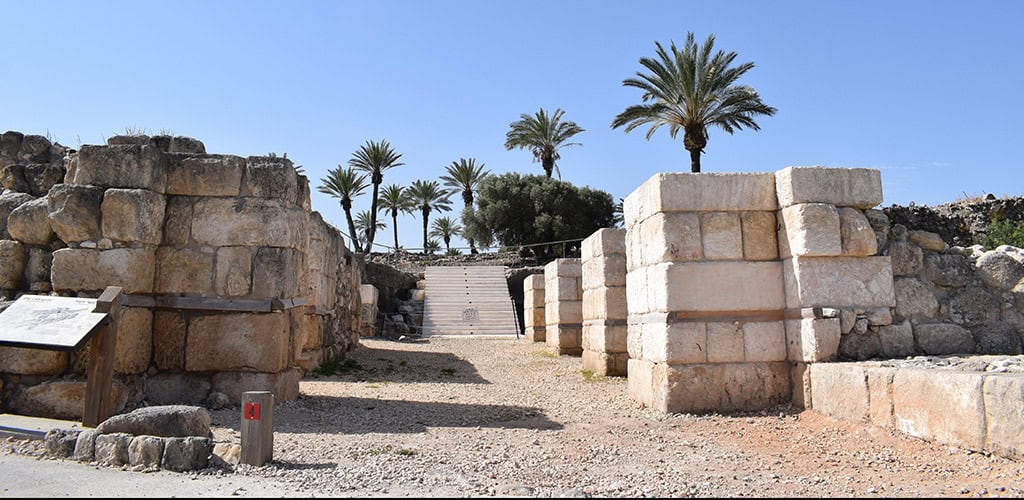
Megiddo is the mother-lode of the chronology and archaeology of the ancient periods in the Land of Israel. However, It is a complex site to understand. The site has 30 layers of civilization, stacked one on top of the other, spanning 4,000 years. Parts of the site are still unexcavated, others have been removed by the various archaeological expeditions.
Ancient cities in the Levant developed due to a few key factors; a perennial source of water, arable land, a secure location, and being on a significant crossroads through the ancient world. Megiddo had all three. It is located on a small hill overlooking the fertile Jezreel Valley; a relatively large spring emanates from the foot of the hill, and its location controls the most important highway of the ancient world – the road connecting the two principal river civilizations – Egypt, and Mesopotamia.
The Israelite Gate
Walk up the iron steps to the Six-Chambered Israeli gate. The gate had two towers in front of it — the foundations still clearly visible, a large plaza in front of the gate — with fortifications around it. Further down the road leading to the plaza remains of another tower can be seen. Even further down are a series of steps — that we passed on the path to the Bronze Age gate. This served as a pedestrian approach to the gate.
The three Iron Age layers of biblical Megiddo, are the most controversial of the site’s layers. These three layers out of thirty have been at the forefront of archaeological controversy for over fifty years.
The last Canaanite layer of Megiddo, layer VI, was destroyed by a massive blaze during the first half of the 10th century BCE. Most of the population was massacred, the buildings demolished, the temples burnt, and the city destroyed. On the ruins of Canaanite Megiddo, a new settlement arose with a population that had no affinity with the former Canaanite city.
The first Israelite layer, VB, is the earlier part of layer V. It was founded in the last third of the 10th century, somewhere around 920 BCE. Its beginnings was a group of structures on the Megiddo hill, one of them probably larger than the others, maybe a fortress or governor’s house. The date of the founding of this first Israelite city is crucial. Those who try to push the date back can attribute it to the United Kingdom of David and Solomon. Others, who claim that there was no Davidic Golden Age, attribute the founding of layer VB to the local Israelite tribes, who would eventually come together to form the Northern Israelite Kingdom.
Two controversial biblical verses attribute Megiddo to Solomon. I Kings 9: 15 reports that Solomon built “Jerusalem, Hazor, Gezer, and Megiddo.” Yigael Yadin took this as proof that Solomon built fortifications and gates in all these cities. Yadin led an excavation in the 1960s to prove this point. I Kings 4: 12 recounts that Solomon had “12 governors over Israel” among them Baana, son of Ahilud, the governor of “Ta’anakh, Megiddo, and all Beit She’an.” Did Solomon’s kingdom ever reach as far as the Jezreel Valley? Could the flimsy first Israelite settlement of Megiddo be attributed to Solomon, even though the early Kingdom of Israel is a more plausible contention?
One of the earliest finds of the Chicago excavation was a 26-centimeter inscribed basalt base of a stela set up in Megiddo by Pharaoh Sheshonk – biblical Shishak. This Pharaoh conducted an aggressive military campaign in the Land of Israel recorded in the Bible, on the walls of the temple of Amon in Karnak, Egypt, and the stela from Megiddo.
Shishak’s campaign took place around 925 BCE. According to the Biblical and Egyptian accounts, it left a path of destruction throughout the country. However, there are no signs of destruction or battle on layer VB. The first Israelite layer developed gradually into the next layer. It is not logical to assume that Shishak would place a victory stela on a ruined city. Therefore, it would seem that the Egyptian Pharaoh was attempting to renew Egyptian control of the land, hence the victory column at Megiddo, which stood in the last Canaanite city, placing the first Israelite layer after 925 BCE. Shishak died three years after the campaign, and further attempts by the Egyptians to renew their empire in the east did not materialize. It seems logical to assume that layer VB was settled after the local Israelite tribes had devastated the last Canaanite city at Megiddo — sometime toward the end of the 10th century BCE and beginning of the 9th. The Biblical David and Solomon were long gone be then.


